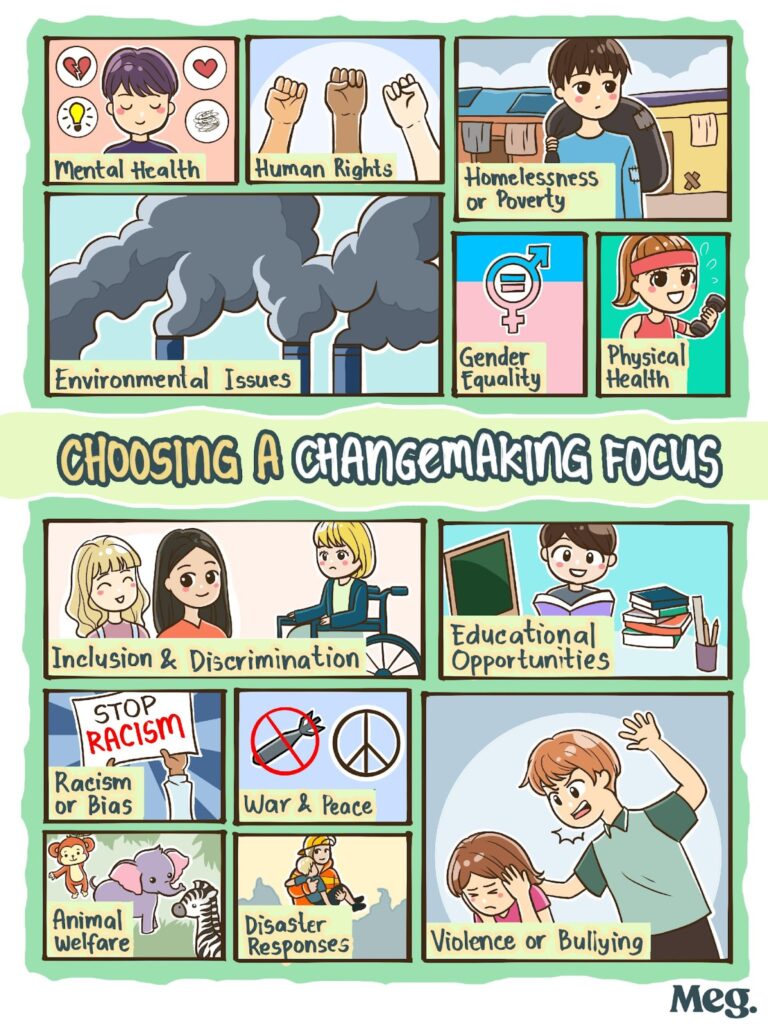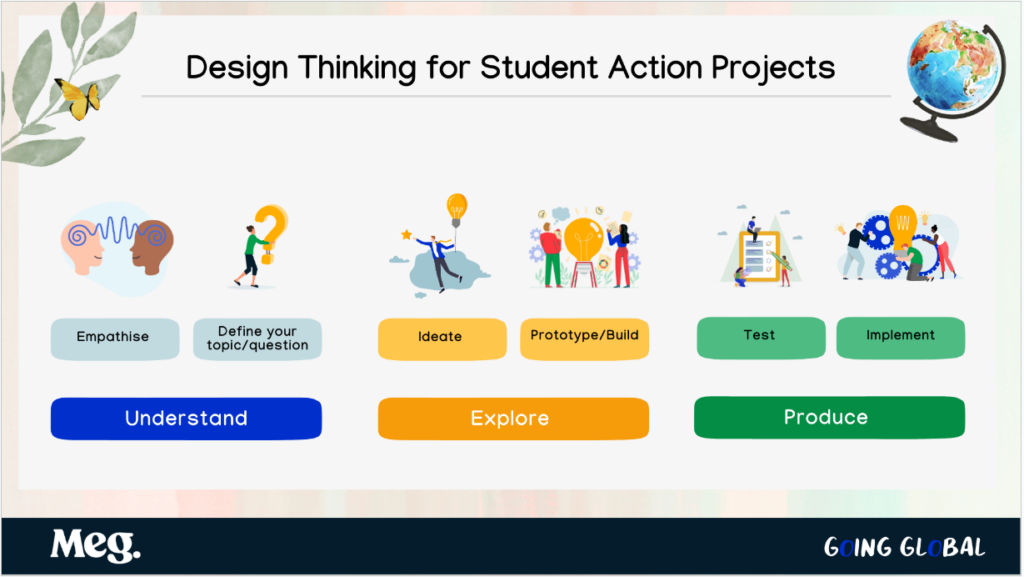Student Voice, Student Choice: An Educator’s Guide to Student Action Projects
When I was a college student, my Theory 4 professor whom most of us had already known for years introduced himself as our Guide. Not as the ‘Doctor’ he had earned many years before or even as ‘Professor’… Dr. E would now be serving as our Guide through the wonderful world of advanced music theory.
Fast forward to my journey as an educator and this experience still flashes every time I prepare a lesson. How can I as an educator lean into the role of “Guide on the Side” vs. the less contemporary “Sage on the Stage”?
As awareness grows around the importance of student voice, for engaged and self-directed learners, more educators are asking themselves, how do I put students in the driver’s seat of their learning?
Enter student action projects.
“These projects empower students not only to care about the issues impacting them and the world in which they live, but also to take action to change things for the better.”
– Steph Pacharz
What are Student Action Projects?
Student Action Projects provide the opportunity for students to apply skills they have learned in the classroom to real-world scenarios. Steph Pacharz, Education Specialist at Meg Languages, says, “These projects empower students not only to care about the issues impacting them and the world in which they live but also to take action to change things for the better.”
What steps need to be taken by the students to get started?
Steph, who spent several years as an International Baccalaureate (IB) educator and coordinator, draws similarities between IB programming and student action projects. “If you are familiar with the International Baccalaureate, you likely already have an understanding of student agency. Agency refers to a student’s belief in themselves to set a goal, carry out steps to work toward that goal, and eventually meet it. There is more collaboration with rather than dependence upon a teacher to carry out this process. Students take ownership of their learning from the start, beginning with issues that are important to them.”
These aspects are the foundation for supporting a Student Action Project.
Students need to identify a problem or issue they care about. These initial brainstorming sessions might even mean that there are more ideas than you know what to do with – and that’s great. “In some cases, the conversations that stem from the brainstorms may even lead the projects in a completely new direction,” says Steph.
As long as it is student-led, it is going in the right direction.
“The role of the educator at this point is to help students navigate the conversations around action topics, ultimately helping them to arrive at a decision that feels meaningful to them,” adds Steph.

Oftentimes, students pick a social or environmental issue that resonates with them or impacts their community on a local or global level. “Students may even choose a topic that is very personal to them,” Steph mentions. Whatever topic they land on, it can almost always be connected to the UN Sustainable Development Goals (SDGs). These goals, which are part of the 2030 Agenda for Sustainable Development, are a call to action for all countries to work together in global partnership to address issues impacting the planet we all share. The SDGs can be introduced and shared with students along the way, giving further direction to their work.

It is critical for students to understand that there are many different ways to participate in a student action project. Steph reminds us, “A common misconception I encountered in my time as a teacher and coordinator in IB schools was the thought that the action students were taking needed to be a grand production. Action doesn’t necessarily need to be a huge thing. Small actions matter too and can make just as meaningful of an impact. In fact, it is success in these small actions along the way, in my opinion, that lead to increased likelihood of success in attempting to take action on a larger scale.”
What are the essentials educators should keep in mind when facilitating student action projects?
If you are anything like me, you probably had a little sense of dread as you worried about the chaos that could possibly ensue, and believe me, I get it. I have felt the same way.
But, I am TELLING you, it is pure magic when you see the students take ownership of this work.
So, you are not the ‘Sage on the Stage’ and the lesson time is not centered around you as the teacher…what does supporting student action projects look like then?
Design Thinking to support project structures
At Meg, we use Design Thinking for our Student Action Projects. It provides a strong foundation to guide the self-directed work of students and clearly lays out the ‘next step’ to progress with projects and ideas.
According to the Harvard School of Education, “Design Thinking is a mindset and approach to learning, collaboration, and problem-solving. In practice, the design process is a structured framework for identifying challenges, gathering information, generating potential solutions, refining ideas, and testing solutions. Design Thinking can be flexibly implemented; serving equally well as a framework for a course design or a roadmap for an activity or group project.”

In this graphic, you can see how Design Thinking is broken down into 3 main phases and a total of 6 sub-phases.
During the Understand phase, students must first Empathize with the problem, issue, or topic they plan to work on. Without them truly caring about this topic they are unlikely to be motivated to solve the issue, find solutions and stay on task for the rest of the project. Empathy drives motivation.
Then, they can Define the Topic/Question they have decided to explore. For example: How can we make our school more sustainable?
The Explore phase allows students to Ideate and then Prototype/Build solutions to the issue they have addressed. This is where you as the teacher will see a lot of divergent and then convergent thinking. In divergent thinking, students are encouraged to brainstorm and create as many possible ideas as they can come up with, it might look like a bunch of post-it notes stuck up on the wall. All ideas are welcome!

You will see that many of those ideas have absolutely nothing to do with each other or are too micro or too macro to address – and that’s okay. From here you guide the students to select the best idea or ideas – this is where the convergent thinking takes place. You (and more importantly your students!) will see the connections between what they have already come up with.
Choosing a problem/issue/topic to work on is where you will use a clear Divergent/Convergent thinking process, but it is worth noting that as the project progresses and solutions to challenges the project faces need to be found, students will continue to use Divergent/Convergent thinking in mini-tasks throughout the process.
“Flexibility is a key strength to keep in mind. Projects change and evolve over time, action steps change, ideas change. Divergent and Convergent thinking offer additional avenues of exploration for action,” added Steph.
And finally, it is time to Produce. In this phase students Test and Implement their project. There may even be layers to their project that have different launch points or tweaks to be made along the way. In our projects, the implementation phase is the primary focus, as there is typically no product to test, per se. As the project is implemented, students will reflect frequently.
Tips on facilitating projects successfully
1. Help them to develop research skills and identify resources
As part of the Explore phase, students will begin identifying resources that could be helpful for their projects.
The number of potential resources that students can stumble upon is staggering. Some will be fantastic and others will come from dubious sources and students need to know what questions to ask to weed out the good from the bad using their Digital Citizenship skills.
I do think it is always good for educators to offer a curated list of websites and sources. Your district or school might already have some preferred places to start, so check out those options first. Your school librarian or media specialist will also be able to help!
During their research, students should consider the following:
- The organization or individual responsible for the site and any bias they may have as a result of their affiliations – what is their motivation?
- The expertise of the author – have they studied the topic for many years?
- The date on which the content was published/updated – is the content a few years old or several decades old?
For more tips on identifying appropriate sources, check out Edutopia’s “8 Tips to Help Students Evaluate Websites.”
2. Research can feel overwhelming.
Encourage students to read articles and watch videos they think might be helpful in addressing their topic/question. They should take notes and make summaries of key information – it can be tempting to get lost in the details at the beginning, but keep the note-taking broader in these early stages and note the source from which you found the information. They can always come back and fill in the gaps if they need more details.
3. Make connections with experts in the field
It is time to unleash the power of your, and the students’, networks! As students build and implement their projects, encourage them to think of people they know who can support the project.
Whether it is a local professor who specializes in a topic the students decide to research or a general manager at a store who can donate supplies to students as they begin the implementation of their projects, these experts are there and – more often than not! – incredibly honored to take part in the process. Students are connected to the community in ways we often don’t see, so take the time to brainstorm together who might support the projects.
Adds Steph, “This could lead to additional support for their cause or inspire others to join in!”
Help students gather the information they need and encourage them to begin the outreach process themselves. Those first responses they receive back will feel like major wins and when they hit barriers with their outreach, they develop the skills of persistence, problem-solving, and grit.
4. Encourage collaboration
Collaboration is critical to how the project will be built and implemented.
“For many of us, collaboration with others within the workplace is part of everyday life,” Steph shares. “We work on dynamic teams that utilize the strengths and expertise of each of their members to execute tasks and projects. The very same methodology is applied to student action projects, where collaboration is essential to success.”
Steph adds, “As educators, it is our job to create an environment within our classrooms that fosters collaboration, allowing students to see the value in working together to achieve a common goal. This can include providing opportunities for peer reflection and feedback, explicitly teaching communication and teamwork skills, and guiding students through the process of seeking out experts in their project fields. These connections provide students with real-world skills and open up entirely new avenues of partnership, introducing students to others who hold similar passions. By collaborating with others, students develop their communication skills, increase their accountability, execute projects that represent more diverse perspectives, and improve problem-solving skills that will surely benefit them in the long run.”
5. Create a safe space
As your students embark on the brainstorming process, set the tone that all ideas are truly welcome. Sharing an idea that is personal is a real challenge for some. Creating a classroom community where judgment is unwelcome and kindness is always key, will reinforce to students the type of classroom community you expect them to operate in.
Encourage students to overcome challenges or even take them as an opportunity to make a creative pivot. It is a process that takes time and thought – and then more time and even more thought!
Ensuring that students feel emotionally and intellectually safe in this environment will pay dividends in the types of projects they produce. The growth they experience will have a lasting impact as a result.
6. Provide actionable feedback
As projects progress, you might see opportunities for further exploration appear. Share those insights with students. Give them ideas of which routes they can consider and ask them about the routes they have already taken. They may discover that there is a more efficient way to carry out one of their project tasks. Or, your suggestion could be the missing piece to the puzzle they were trying to solve!
“On the flip side,” Steph mentions, “they could also choose to proceed in their own unique way, taking in very little or potentially none of your suggestions. That’s ok too! Some of the most impactful lessons we learn follow behind the risks we take in learning.”
7. Allow creativity and innovation
My best advice here is this – try not to overly curate the experience. We have all seen those student projects in which there appears to have been a heavy-handed adult waving their polishing wand over EVERYTHING. While it is GREAT to have an adult there to keep an eye on things, it is imperative that student creativity is given the opportunity to shine.
And in terms of innovation, these kids were born into a world of innovation where everyone is a creator, with a smartphone in their pocket. They are tech natives – ready to be innovators themselves. Let them spread their wings and fly!
Students are ready to Produce their projects – implement and fine-tune along the way.
8. Ask questions and provide students with opportunities to reflect
Reflection is often reserved for the end, but it works best when it is a constant thread – woven throughout the process. Review the Design Thinking process and note the points at which it is a good time to pause and reflect on what has happened so far:
Ask questions like:
- What else might you need to be successful in the next step of the project?
- Is anything missing that you haven’t considered yet?
- What’s been the biggest challenge so far?
- What have you learned from <fill in the blank> that did not go as planned?
- Is there a responsibility that someone will need to take on as you head into the next phase?
Just like the feedback, they may go their own way! But the pause for reflection will give them time to really sit back and look at the big picture more frequently.
9. Celebrate milestones
Using the Design Thinking process as your guide, celebrate all of the little milestones along the way.
Your students landed on a topic of interest? Celebrate it!
Your students delegated roles and responsibilities? Celebrate it!
Your students received an answer to the email they sent to a local representative? Celebrate it!
Some projects will have a clear destination which is another incredible point to celebrate. Some projects will establish something that will live on for years to come. Every single one of these is worth a celebration because your students built this from the ground up.
The work of amplifying student voices is critical to education now more than ever. And we are here to support you every step of the way!
If you are interested in partnering with us, check out our Student Action Programs to find a solution that works for you!

Emily is the Client Solutions Manager for Meg’s US and UK markets and is based in Nashville, TN. Prior to moving into the world of EdTech, Emily spent 11 years in the classroom, teaching both music and Social Studies. Her experience ranges from early childhood education to adult professional learning. An eternal learner herself, Emily enjoys making connections through education in an effort to better understand others and the world we live in. Connect with her on LinkedIn.

Steph is an educator and lifelong learner with a strong teaching background at the early childhood and elementary levels. In addition to her classroom teaching experience, Steph has also served as an International Baccalaureate Primary Years Program Coordinator, delivering impactful professional development programs at the school and district levels. At Meg Languages, Steph works as an Education Specialist, creating engaging products for language and culture learning, using innovative technology and pedagogical approaches to foster global citizenship among students. Connect with Steph on LinkedIn!
Share this post

